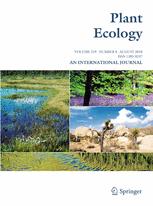Ver ítem
- xmlui.general.dspace_homeCentros Regionales y EEAsCentro Regional Catamarca - La RiojaEEA CatamarcaArtículos científicosxmlui.ArtifactBrowser.ItemViewer.trail
- Inicio
- Centros Regionales y EEAs
- Centro Regional Catamarca - La Rioja
- EEA Catamarca
- Artículos científicos
- Ver ítem
Differential water-use strategies and drought resistance in Trichloris crinita plants from contrasting aridity origins
Resumen
In arid environments, water availability is the main limiting factor for primary production, and it is expected that not only drought-resistance, but also plant strategies for soil water use will be under natural selection. Our aim was to investigate the strategies of soil water use and the responses to water shortage that lead to variability in drought resistance in Trichloris crinita plants (a native forage grass of northwestern Argentina) from sites
[ver mas...]
In arid environments, water availability is the main limiting factor for primary production, and it is expected that not only drought-resistance, but also plant strategies for soil water use will be under natural selection. Our aim was to investigate the strategies of soil water use and the responses to water shortage that lead to variability in drought resistance in Trichloris crinita plants (a native forage grass of northwestern Argentina) from sites with contrasting aridity. We established a common-garden experiment with plants from relatively “arid” and “humid” sites (326 and 625 mm mean annual precipitation, respectively). During 6 weeks, plants were subjected to two contrasting watering levels: control and drought. We found different water use strategies and drought resistance between plants from arid and humid sites: the former used water more conservatively and grew more under drought. During the first 2 weeks of the drought treatment, plants from arid sites dried out the soil slower than those from humid sites. Plants from arid sites subjected to drought showed less leaf senescence and a greater leaf elongation rate and biomass of green leaves than those from humid sites. This variability in adaptation to drought in T. crinita plants could be used to select plant materials for arid land revegetation or to be incorporated into breeding programs for forage purposes.
[Cerrar]

Autor
Quiroga, Raul Emiliano;
Fernandez, Roberto J.;
Golluscio, Rodolfo Angel;
Blanco, Lisandro Javier;
Fuente
Plant Ecology 214 (8) : 1027–1035 (August 2013)
Fecha
2013-08
ISSN
1385-0237
1573-5052
1573-5052
Formato
pdf
Tipo de documento
artículo
Palabras Claves
Derechos de acceso
Restringido
 Excepto donde se diga explicitamente, este item se publica bajo la siguiente descripción: Creative Commons Attribution-NonCommercial-ShareAlike 2.5 Unported (CC BY-NC-SA 2.5)
Excepto donde se diga explicitamente, este item se publica bajo la siguiente descripción: Creative Commons Attribution-NonCommercial-ShareAlike 2.5 Unported (CC BY-NC-SA 2.5)

